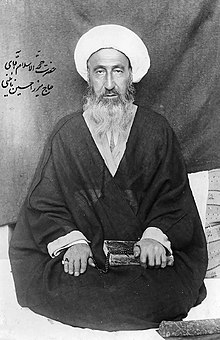Mohammad-Hossein Naini | |
|---|---|
شيخ محمد حسين نائينى غروی | |
 | |
| Personal | |
| Born | May 25, 1860 |
| Died | August 14, 1936 (aged 76) Najaf, Iraq |
| Resting place | Imam Ali Shrine |
| Religion | Islam |
| Nationality | Iranian |
| Region | Najaf, Kingdom of Iraq |
| Jurisprudence | Twelver Shia Islam |
| Main interest(s) | Islamic philosophy, Usul al-fiqh |
| Notable work(s) | Tanbih al-Ummah wa Tanzih al-Milla Vassilat'un Nijat Ressalat la Zarar |
| Muslim leader | |
| Based in | Najaf, Iraq |
| Period in office | 1911–1936 |
| Predecessor | Akhund Khorasani |
| Successor | Abu al-Hasan Isfahani |
Grand Ayatollah Sheikh Mohammad-Hossein Naini Gharavi (Persian: محمد حسین نائینی غروی; May 25, 1860 – August 14, 1936) was Iranian Shia marja'.
His father Mirza Abdol Rahim and grandfather Haji Mirza Saeed, both one were Sheikhs of Nain and Mohammad Hussein proved himself the most competent student of Ayatollah Kazem Khorasani. Ayatollah Naini is considered to be the most famous theoretician of Iran's Constitutional Revolution. He died in 1936 and was buried next to shrine of Imam Ali in Iraq. Among his works, notable references are his Dubios Habit, Vassilat'un Nijat, and Ressalat la Zarar. 50th death anniversary of Ayatollah Mirza Mohammed Hussein Naini was memorialized by issue of Stamps Tickets, in Iran, in 1987.[1]